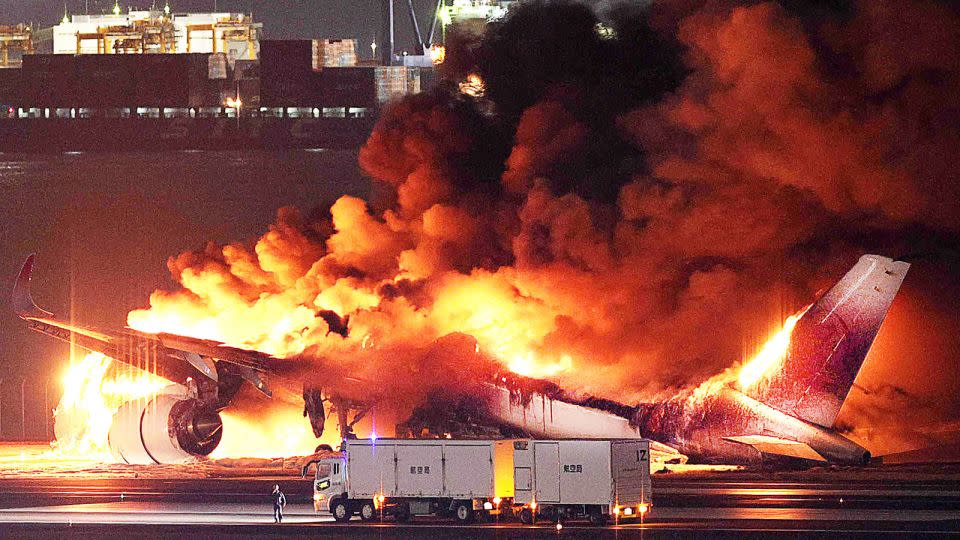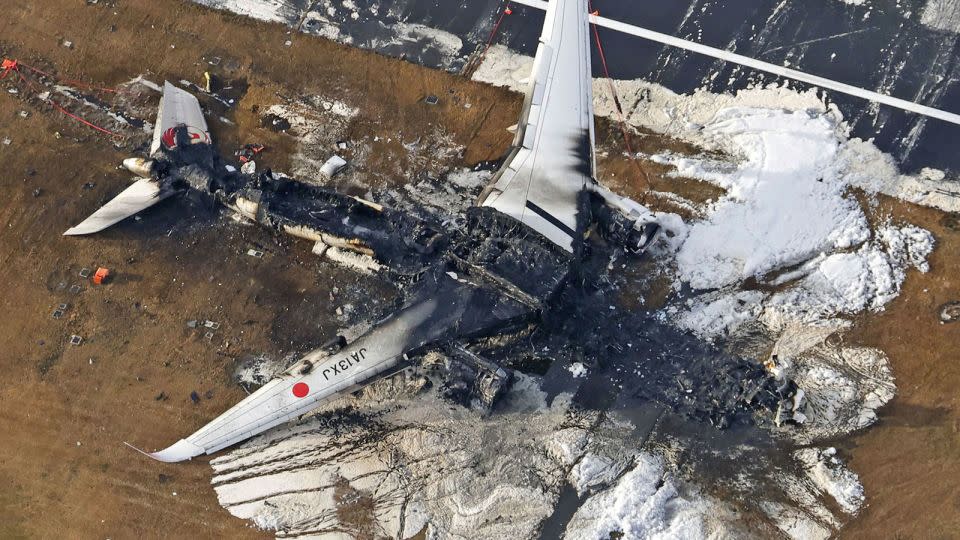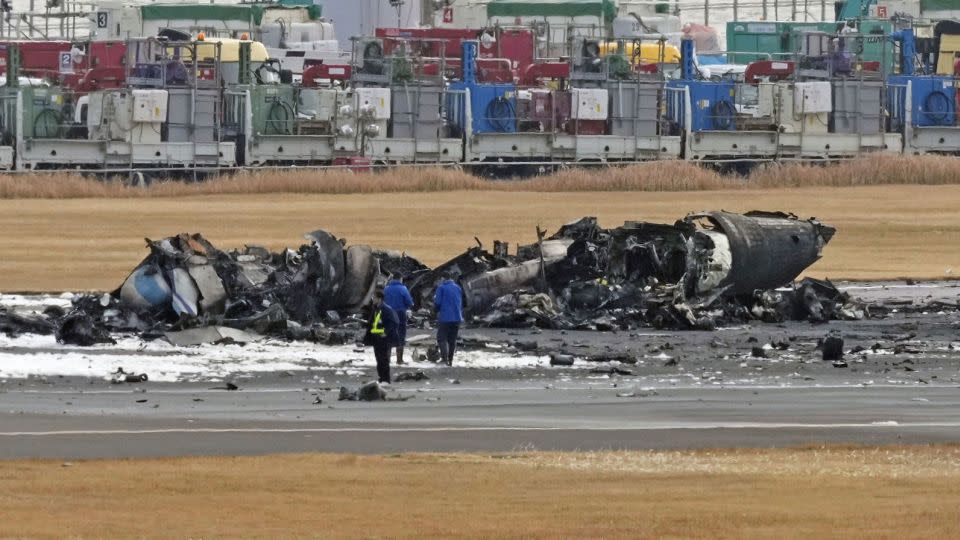Miracle at Haneda: Passengers describe terror and relief after fiery Japan Airlines collision
- Oops!Something went wrong.Please try again later.
When Japan Airlines flight 516 touched down at Tokyo’s Haneda airport carrying hundreds of people on Tuesday it erupted into a terrifying fireball.
The Airbus A350 passenger plane had collided with a coast guard aircraft on the runway – killing five people – and the crew had just minutes to ensure all passengers were evacuated before flames consumed the entire plane.
As smoke rapidly filled the cabin, flight attendants used megaphones to calm and corral anxious passengers, who escaped through three exits on emergency slides.
All 379 people on JAL flight 516, including eight children under the age of two, were safely evacuated – a feat that surprised aviation experts and has been described as miraculous by some on board.
“I heard an explosion about 10 minutes after everyone and I got off the plane,” 28-year-old passenger Tsubasa Sawada told Reuters. “I can only say it was a miracle, we could have died if we were late.”
Japan Airlines said four of its passengers were taken to hospital, but the worst injury reported was that one person sustained “bruising.”
Five of the six crew members died on the second aircraft, a De Havilland Canada DHC-8, according to Japan’s transport minister, Tetsuo Saito. Public broadcaster NHK said the plane’s captain was in a critical condition.
Japan Airlines is taking part in the investigation to determine who is responsible for the deadly crash, its senior vice president of corporate safety and security, Tadayuki Tsutsumi, told reporters.

The airline said its crew had been cleared to land by air traffic control before the collision. Audio from LiveATC.net appears to detail the crew reading back a clearance order for runway 34, saying “cleared to land 34 right.”
An official written transcript of communications between air traffic controllers and the two planes involved, released on Wednesday, shows that air traffic control gave the JAL passenger plane permission to land on Runway C at 5:43:26 p.m. local time (3:43:26 a.m. ET).
However, the transcript does not show clear takeoff approval for the coast guard plane, instead, telling it to “taxi to holding point” at 5:45:11 p.m. (3:45:11 a.m. ET).
In a press conference Wednesday, Japan’s minister of land, infrastructure, transport, and tourism, Tetsuo Saito, told reporters that the next step in the investigation will be to listen to the audio recording of the conversation between the pilot and flight control tower.
In a briefing following the conference, officials from the Japan Transportation Safety Board (JTSB) said they had retrieved the flight and voice recorders of the coast guard aircraft. However, they added that they were still looking for those of the JAL plane.
A JTBS official told reporters that the air traffic controller cleared the Japan Airlines plane to land on runway C and instructed the coast guard aircraft “to hold point.”
Passengers onboard the Airbus A350 and witnesses to the collision described terror giving way to relief as it became clear everyone onboard survived.
“I really thought I was going to die,” Sawada said, according to Reuters.
Runway incursions, as this is classed, are “rare but can be catastrophic,” said Graham Braithwaite, professor of safety and accident investigation at the UK’s Cranfield University.
Guy Maestre, originally from France, was on board an adjacent plane at the time of the incident and described hearing a “big bang.”
“I was in another plane in the window seat – we were getting ready to take off and we heard a big bang. We looked from our windows and saw a huge trail of flames running down the runway,” Maestre, who had been visiting Japan from Philadelphia, told CNN.
“Flames got higher and higher then we saw fire trucks go by the runway.”
“I was hoping everyone was going to be safe,” he said, adding that it was “shocking to see.”
Despite the horrific images broadcasting the fiery crash, passenger Satoshi Yamake told CNN that people inside the plane were not panicking.
When the flight landed, Yamake said he initially didn’t feel anything out of the ordinary.
“We landed normally, didn’t feel a shock or anything,” Yamake said at Haneda airport after he was evacuated from the crash.
He added that he saw a fire shortly before an announcement was made to evacuate the plane.


“But then we saw fire coming out of the engines and I found it strange. Just as I was thinking why the fire was burning for so long, an announcement came and said we probably hit something on the runway and we have to now evacuate the plane,” Yamake said. “We could smell some smoke but passengers were not panicking a lot.”
He said he “was not really scared.”
“Since we have landed already, I was thinking the plane probably won’t explode by this point. We should be fine as long as everyone gets off the plane in an orderly manner.”
The crew of Flight 516 have been praised for their speedy and cool-headed reactions that saved hundreds of lives.
Japan Airlines said the cabin crew used megaphones to direct passengers to safety after the plane’s inflight announcement system malfunctioned.
Reports from inside the plane say flight attendants urged people to remain calm and within seconds of the plane coming to a standstill, were able to deploy the escape chutes and usher passengers off.
“It’s too soon to comment on the specifics of the incident, but what’s clear is that the crew performed in an exemplary fashion,” said Steven Erhlich, chair of PilotsTogether – a charity set up in the pandemic to support crew.
He cited the fact that the passengers on the flight evacuated without taking their carry-on bags with them, which helped save lives.
“Any delay in evacuation could have been catastrophic, all for the sake of a laptop or carry-on bag. This incident could have been far worse if passengers hadn’t heeded the warnings to leave their belongings behind,” he said.
Yamake’s wife, Mika, told CNN her husband “came out with his mobile phone. He had to leave everything else behind.”
“He called me from inside and told me he saw smoke coming out. I was relieved he was safe,” she said.
CNN’s Julia Buckley, Sophie Jeong, Teele Rebane, Mayumi Maruyama and Eric Cheung contributed reporting.
For more CNN news and newsletters create an account at CNN.com

